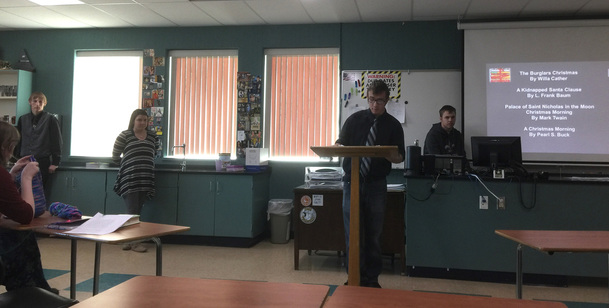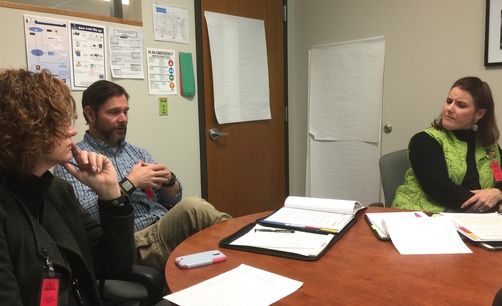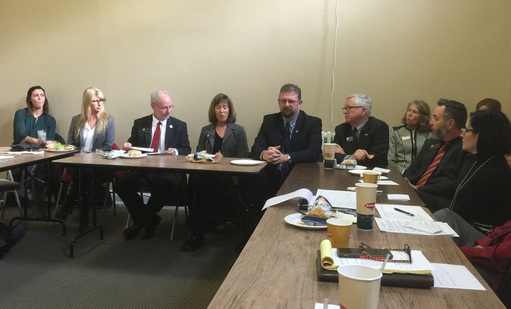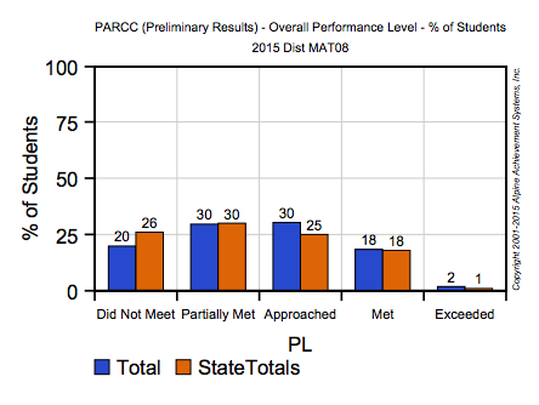Echoes from Cañon
Examples of Excellence
 A student in Mr. Summer's Vocational English class presents his portion of the debriefing.
A student in Mr. Summer's Vocational English class presents his portion of the debriefing.
On Wednesday I had the pleasure of attending a debriefing session in CCHS Language Arts teacher Bill Summers’ 2nd Block Vocational English class. This course has been designed for students who feel they may not want to attend college. Yet it has been crafted to prepare them for the way English language skills are used in today's work force. I was quite impressed by the professionalism presenters displayed, and the knowledge they had clearly gained about the important role reading and writing play in today’s workplace, as well as the importance surrounding how an individual conducts himself, both personally and professionally, when it comes to acquiring and keeping a good job. In a world where the philosophical expectation seems to be to prepare all students for college even though a percentage of them will not actually do so, I was very much impressed to see that Cañon City High School offers a class like this that is clearly relevant to the future of each student who participates.
I will be sharing information about the Cañon City School District’s performance on new PARCC assessments later in this publication. However, I could not write this week’s Echoes without celebrating the fact that last year’s 8th Graders performed above the state average in math. We have a long way to go in a lot of areas, but this is certainly a noteworthy accomplishment that we should all recognize!
This week we received word that our Connect for Success Grant aimed at supporting best practices instructional coaching at McKinley Elementary Schools has been given approval by the Colorado Department of Education. Though we will need to make some adjustments to our application, we look forward to this opportunity to further refine the good work already begun at McKinley by supporting the implementation of a comprehensive instruction and intervention program aimed at raising the achievement of our most struggling readers.
I will be sharing information about the Cañon City School District’s performance on new PARCC assessments later in this publication. However, I could not write this week’s Echoes without celebrating the fact that last year’s 8th Graders performed above the state average in math. We have a long way to go in a lot of areas, but this is certainly a noteworthy accomplishment that we should all recognize!
This week we received word that our Connect for Success Grant aimed at supporting best practices instructional coaching at McKinley Elementary Schools has been given approval by the Colorado Department of Education. Though we will need to make some adjustments to our application, we look forward to this opportunity to further refine the good work already begun at McKinley by supporting the implementation of a comprehensive instruction and intervention program aimed at raising the achievement of our most struggling readers.
The Focus of Our Work
 District leaders meet at Academy School District about their salary schedule.
District leaders meet at Academy School District about their salary schedule.
On Tuesday December 15th Director of Finance Buddy Lambrecht, Director of Facilities Jeff Peterson and I met with representatives from the Colorado Department of Education's Capital Construction unit. Our goal was to discuss an effective road forward in writing one, or possibly several, BEST grants. The Building Excellent Schools Today program is a way for school districts to leverage local dollars by receiving matching grant funds to support facilities improvement focused on increasing health and safety issues in school buildings. The questions we were seeking to answer included what would be the best way to package our grant requests, and are there any requirements from CDE regarding how we might hire a grant writer to support our effort? Having received guidance on these matters we will now begin the process of determining what projects to address through this grant program.
On Thursday December 17th I started my day by traveling to the Academy School District in Springs to meet with their human resources director, Misty Manchester, and some of our CCEA representatives about their salary schedule design. We did this as part of our work related to a salary schedule study that was negotiated last spring. We are still trying to address the issue we have regarding several staff members who have been employed in the district for 5 to 6 years and are earning less than some newly hired employees with less experience (because we froze experience steps for many years during the recession).
Later in the day Thursday I was at a roundtable discussion lunch with members of the Colorado Legislative Joint Budget Committee. This was arranged by the Southern Superintendents group that I participate in. At this gathering we talked with the JBC about many topics such as possibly moving the healthcare provider fee out of the realm of TABOR, higher than expected property tax collections and what to do with those dollars, and any other sources of revenue that might be hiding out there that could fuel public education. The meeting wasn't very hopeful in terms of getting answers about specific extra funding that might come our way. However, I believe that all JBC members will be working to at least not increase the education negative factor this year.
On Thursday December 17th I started my day by traveling to the Academy School District in Springs to meet with their human resources director, Misty Manchester, and some of our CCEA representatives about their salary schedule design. We did this as part of our work related to a salary schedule study that was negotiated last spring. We are still trying to address the issue we have regarding several staff members who have been employed in the district for 5 to 6 years and are earning less than some newly hired employees with less experience (because we froze experience steps for many years during the recession).
Later in the day Thursday I was at a roundtable discussion lunch with members of the Colorado Legislative Joint Budget Committee. This was arranged by the Southern Superintendents group that I participate in. At this gathering we talked with the JBC about many topics such as possibly moving the healthcare provider fee out of the realm of TABOR, higher than expected property tax collections and what to do with those dollars, and any other sources of revenue that might be hiding out there that could fuel public education. The meeting wasn't very hopeful in terms of getting answers about specific extra funding that might come our way. However, I believe that all JBC members will be working to at least not increase the education negative factor this year.
Last Week
 Members of the Colorado Legislative Joint Budget Committee discuss education funding with Southern Superintendents.
Members of the Colorado Legislative Joint Budget Committee discuss education funding with Southern Superintendents.
This past week I worked on crunching numbers related to the recent PARCC test results release, attended the CCHS Fine Art of Christmas performance, met with folks from the CDE Capital Construction department, attended Superintendent’s Advisory Council, attended a Fremont County Facilities Corporation meeting, met with CCEA leaders about general concerns, attended to some recommendations for student expulsions, worked on our salary study project, attended a JBC meeting in Denver, met with the RE-2 superintendent and Fremont County’s DHS director about services we can offer children, met with regional superintendents about school finance, and celebrated the holidays with our district administration office staff and our district leadership team.
This Week
 CCHS performance artists and there teachers wish their audience a happy holiday season.
CCHS performance artists and there teachers wish their audience a happy holiday season.
On Monday I meet with Director of Student Support Services Paula Buser about general matters, and will participate in a work session to prioritize facility improvement projects related to our possible BEST grant application. On Tuesday I will be working on general district communications and meeting with a faculty leader from Cañon City High School. On Wednesday I will work on our BEST Grant application and am sure I will be able to find some year end straightening and re-organizing projects to do in my office. I will be taking Thursday and Friday off to Celebrate Christmas with my family.
The Way I See Things
 Cañon City's 8th graders outperformed the State of Colorado on the new PARCC math assessment.
Cañon City's 8th graders outperformed the State of Colorado on the new PARCC math assessment.
Monday December 14th was the official Colorado PARCC test results release day. As a district we wanted to begin our analysis by informing our board of education about our performance from a district level perspective. In the next month or so we will also be sharing results with building leaders and staff members pertaining to the performance of their students.
If you would like to pull these results up for yourself, I encourage you to access the article at this link:
Our goal in looking at PARCC was to see if there was a way to draw a line of correlation between our prior TCAP performance and where we fell in relation to the state average with new PARCC results. We did this because we expected, as did the entire state, that overall achievement results on PARCC would be lower because the test represents a serious heightening of the bar of expectation for each child. We also proceeded on an assumption that because all achievement would be lower around the state, how close we fell to average performance on the 2014 TCAP compared to 2015 PARCC might be the best indicator of whether or not we are on the right track when it comes to making sure our kids learn new state standards.
The first analysis we did was a comparison of our spring 2015 PARCC ELA (English Language Arts) assessment results by grade level to spring 2014 TCAP reading and writing results. Because of the PARCC ELA assessment we no longer have separate reading and writing results. However, we went ahead and compared them to past TCAP reading and writing results as they pertained to average performance in Colorado.
Though based on 2014 TCAP reading results many of our grade levels were performing at or above state average, when looking at spring 2015 PARCC ELA results we found, though we came quite close in some areas, we did not perform at or above state average at any of our grade levels. It is our belief the common denominator was the effect of our previously identified weaknesses in writing when combined with reading in this new ELA assessment. Thus, considering our need to improve our student writing performance, these outcomes were as might be expected for us at this point in time.
Next we did a comparison of 2014 TCAP math outcomes to 2015 PARCC math results. Our suspicion here was because this is simply a more challenging math test, we might expect our prior relationship to state average performance to exist. Unfortunately, this was not the case as well. What we found was that short of 8th grade (who performed above state level), at each grade we seem to have fallen farther away from state average performance than we were in 2014 on the TCAP test. One possible explanation for this is that writing once again comes into play on these math tests. Another is that we had not yet aligned our math curriculum to the new content standards.
I would like to remind everyone that these PARCC results are baseline. As a district we are reviewing them carefully and will be making decisions aimed at more directly teaching to our new standards, and as a by-product having our students display greater mastery of them. This will be a multi-year process. However, we remain fully committed to producing the best learning outcomes for our children no matter how they will be measured.
Thank you so much for your time.
George S. Welsh
If you would like to pull these results up for yourself, I encourage you to access the article at this link:
Our goal in looking at PARCC was to see if there was a way to draw a line of correlation between our prior TCAP performance and where we fell in relation to the state average with new PARCC results. We did this because we expected, as did the entire state, that overall achievement results on PARCC would be lower because the test represents a serious heightening of the bar of expectation for each child. We also proceeded on an assumption that because all achievement would be lower around the state, how close we fell to average performance on the 2014 TCAP compared to 2015 PARCC might be the best indicator of whether or not we are on the right track when it comes to making sure our kids learn new state standards.
The first analysis we did was a comparison of our spring 2015 PARCC ELA (English Language Arts) assessment results by grade level to spring 2014 TCAP reading and writing results. Because of the PARCC ELA assessment we no longer have separate reading and writing results. However, we went ahead and compared them to past TCAP reading and writing results as they pertained to average performance in Colorado.
Though based on 2014 TCAP reading results many of our grade levels were performing at or above state average, when looking at spring 2015 PARCC ELA results we found, though we came quite close in some areas, we did not perform at or above state average at any of our grade levels. It is our belief the common denominator was the effect of our previously identified weaknesses in writing when combined with reading in this new ELA assessment. Thus, considering our need to improve our student writing performance, these outcomes were as might be expected for us at this point in time.
Next we did a comparison of 2014 TCAP math outcomes to 2015 PARCC math results. Our suspicion here was because this is simply a more challenging math test, we might expect our prior relationship to state average performance to exist. Unfortunately, this was not the case as well. What we found was that short of 8th grade (who performed above state level), at each grade we seem to have fallen farther away from state average performance than we were in 2014 on the TCAP test. One possible explanation for this is that writing once again comes into play on these math tests. Another is that we had not yet aligned our math curriculum to the new content standards.
I would like to remind everyone that these PARCC results are baseline. As a district we are reviewing them carefully and will be making decisions aimed at more directly teaching to our new standards, and as a by-product having our students display greater mastery of them. This will be a multi-year process. However, we remain fully committed to producing the best learning outcomes for our children no matter how they will be measured.
Thank you so much for your time.
George S. Welsh
